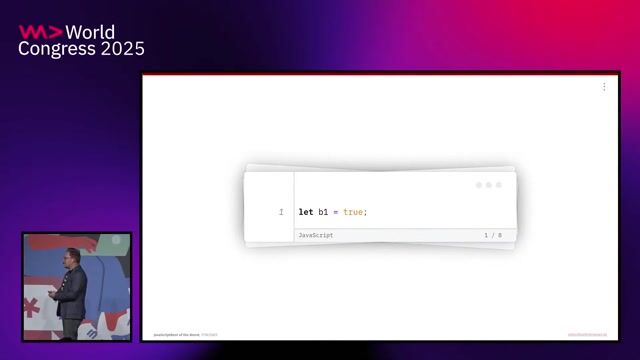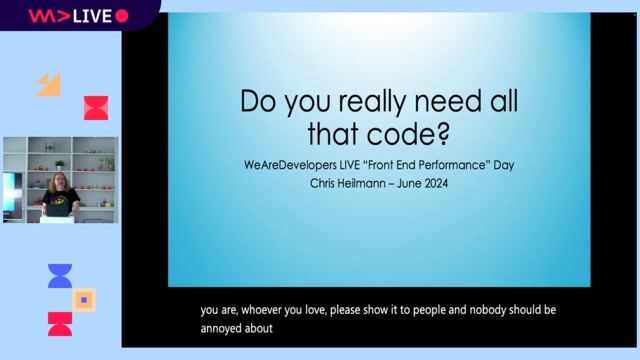Rob Richardson
JavaScript the Grumpy Parts
#1about 3 minutes
The origin and design philosophy of JavaScript
JavaScript was created in 10 days with a core design goal of keeping code running, which explains why early bugs and quirks were never fixed.
#2about 5 minutes
Understanding JavaScript's forgiving nature and its quirks
JavaScript's design prioritizes keeping code running, leading to features like automatic semicolon insertion and strange behaviors like `typeof null` returning 'object'.
#3about 4 minutes
How the two-pass compiler enables variable hoisting
JavaScript's two-pass compiler first allocates memory for variables and then executes code, which explains why variables can be accessed before their declaration.
#4about 11 minutes
Variable scope examples and global scope pollution
Failing to declare variables with `var` can cause them to be implicitly created on the global scope, leading to unintended side effects and bugs.
#5about 12 minutes
Understanding block scope with `let` and `const`
ES6 keywords `let` and `const` introduce block-level scope, which prevents variables from leaking and helps avoid common bugs found with function-scoped `var`.
#6about 6 minutes
The `this` keyword as the thing to the left of the dot
The value of `this` is determined by the execution context, or 'the thing to the left of the dot', which can cause unexpected behavior inside callbacks like `setTimeout`.
#7about 6 minutes
Explicitly setting `this` with `call` and `bind`
Use `call` to invoke a function with a specific `this` context immediately, or use `bind` to create a new function with a permanently bound `this` value.
#8about 6 minutes
How arrow functions provide lexical `this` binding
Arrow functions capture the `this` value from their surrounding lexical context at creation time, which solves common callback issues but also means their `this` cannot be rebound.
#9about 6 minutes
Visualizing the JavaScript event loop and call stack
JavaScript uses a single-threaded event loop with a call stack and a callback queue to handle asynchronous operations without blocking the main thread.
#10about 5 minutes
Interoperability between `async/await` and promises
Because `async/await` is syntactic sugar over promises, you can seamlessly mix styles by awaiting a promise or using `.then()` on an async function's return value.
#11about 9 minutes
Q&A: Arrow functions and Node.js multithreading
The discussion covers the trade-offs of using arrow functions, which can break context in libraries like Mocha, and explores approaches to multithreading in Node.js.
Related jobs
Jobs that call for the skills explored in this talk.
Matching moments

25:46 MIN
A rapid review of other strange JavaScript features
Best of the Worst – the most awful anti-features in JavaScript, ranked!

56:02 MIN
Why the 'this' keyword remains a confusing concept
Using all the HTML, Running State of the Browser and "Modern" is Rubbish

00:03 MIN
Introduction to JavaScript design patterns
10 must-know design patterns for JS Devs

25:14 MIN
Audience Q&A on patterns, typescript, and frameworks
10 must-know design patterns for JS Devs

25:45 MIN
JavaScript's journey from browser wars to native APIs
The State Of The Web

02:09 MIN
Approaching the live pair programming challenge
Coffee with Developers - Jonathan Tang

00:05 MIN
Ranking the worst features in JavaScript's history
Best of the Worst – the most awful anti-features in JavaScript, ranked!

32:56 MIN
Decoding common javascript obfuscation techniques
Cracking the Code: Decoding Anti-Bot Systems!
Featured Partners
Related Videos
 27:06
27:06Best of the Worst – the most awful anti-features in JavaScript, ranked!
Peter Kröner
 46:46
46:46The Lean Web
Chris Ferdinandi
 30:36
30:36The Eventloop in JavaScript - How does it work?
Christian Woerz
 25:30
25:30The year 3000, a brief history of Web Development
Lorenzo Pieri
 28:13
28:1310 must-know design patterns for JS Devs
Erick Wendel
 27:27
27:27Things I learned while writing high-performance JavaScript applications
Michele Riva
 14:44
14:44Catching up on the basics you don't really need that much code
Chris Heilmann
 20:23
20:23Oh CommonJS! Why are you mESMing with me?
John Nguyen
From learning to earning
Jobs that call for the skills explored in this talk.

Software Engineer
tree-IT GmbH
Bad Neustadt an der Saale, Germany
Remote
€54-80K
Intermediate
Senior
Java
TypeScript
Spring Boot

Angular Developer
Picnic Technologies B.V.
Amsterdam, Netherlands
Intermediate
Senior
RxJS
Angular
TypeScript






